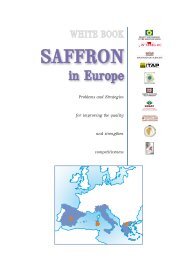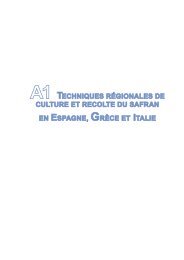Annex White book.pdf
Annex White book.pdf
Annex White book.pdf
Create successful ePaper yourself
Turn your PDF publications into a flip-book with our unique Google optimized e-Paper software.
Odor is a sensation perceivable by the sense of smell when the nosecaptures directly a volatile substance. The odor should be evaluatedregarding intensity, freshness and the absence of non characteristicsmells. The intensity is directly related to quality (or negatively relatedin case of deficiencies). The smell is characterized as deficient when itis combined with smoke, burning, animal flavors, fermentation, rancidness,mould, fried vegetables, rubber, decay and medicines, and manyothers. Fresh odor is the odor related to the origin of the saffron flowersand the products of drying and conservation. New saffron smells lightflowery, sweet and pleasant even if the intensity varies greatly, dependingon the drying method. Older saffron smells intensive, spicy, heavyand is always connected with deficiencies such as rancidness, mouldor to resemblances of fermented objects. Overdrying can give a smell ofburning while bad storage conditions could lead to odor deficiencies. Ifthe group of the atypical odor is unpleasant or does not add anythinginteresting or “special” to the sample then it will have a negative impacton rating.The aroma is perceivable through the rear nasal area. The taste isdetermined through the mouth, using saffron threads or powder dissolvedin water. As soon as the aroma is located it is respectively classifiedto one of the related categories contained in the hand<strong>book</strong> and thegroup as well as the intensity is noted.The bitterness should not be very strong and should create a pleasantand sustaining sensation. Intensive bitter taste can lead to penalties.The persistence of taste describes how long the sensation of tasteremains in the mouth after the sample is swallowed. The remaining tasteshould not be stronger than the taste of the sample held in the mouth.The duration of the stimulus, the after–taste and its nature, must beevaluated.TextureFragility of saffron is a mechanical property of the texture, relatedto the cohesion and the necessary strength for breaking the stigma intopieces. It is obtained by pressing the saffron between the fingers andevaluating its flexibility. In order to obtain high points the sample shouldnot break after pressing, because breaking will mean that the sample isdry or has a glassy texture.Humidity is a superficial property of the texture and relates to theamount of absorbed water by the stigma or the amount of the watershed by the stigma. Saffron should contain a certain amount of waterin order not to look like a straw or loose color when touched by fingers(due to excessive viscosity).160




